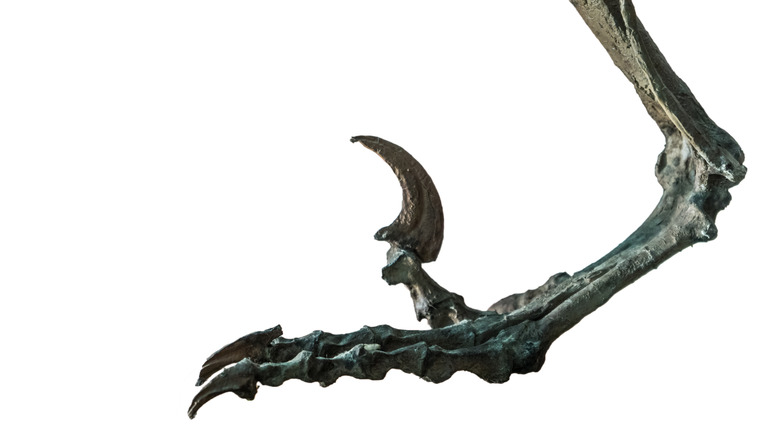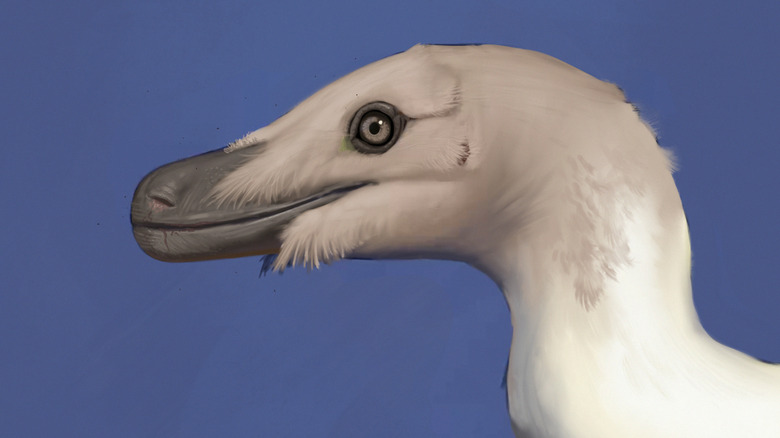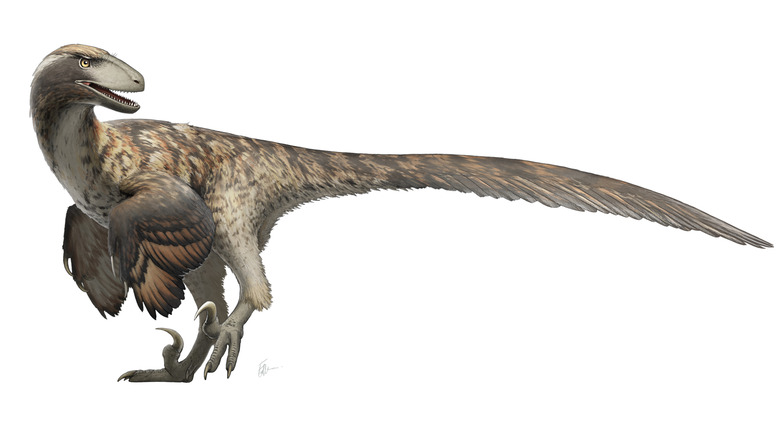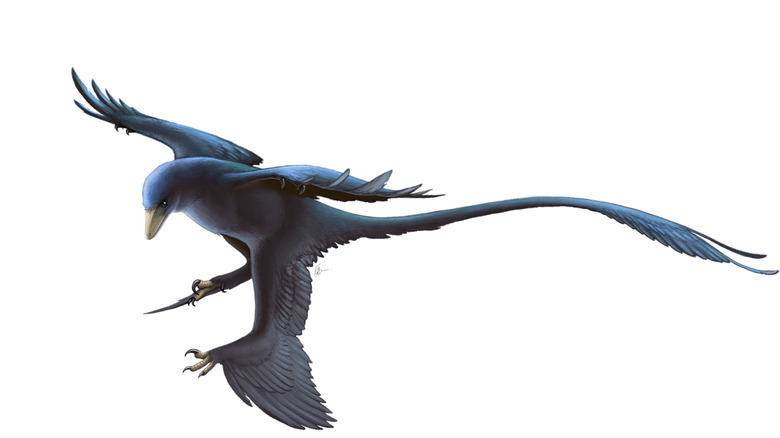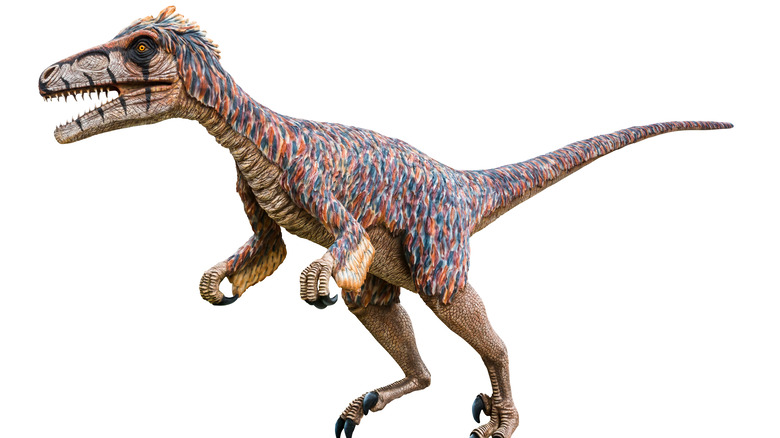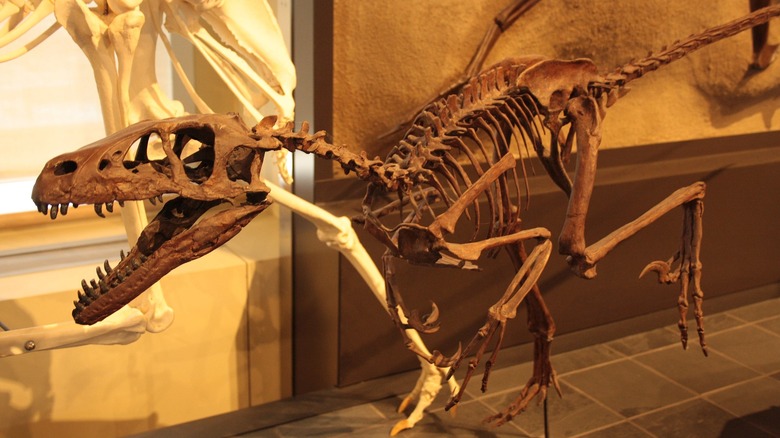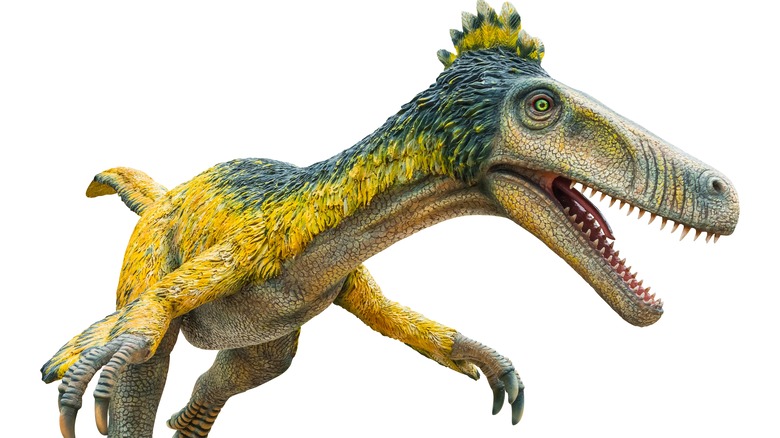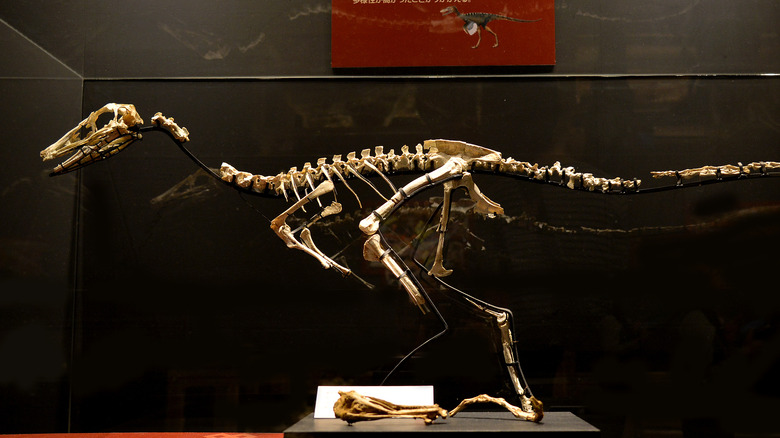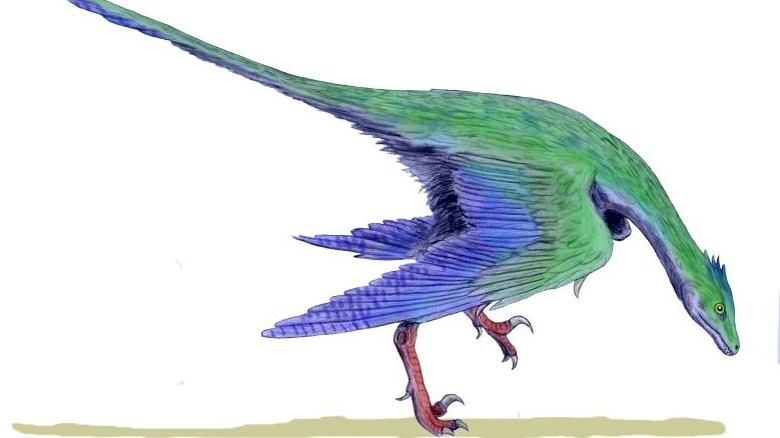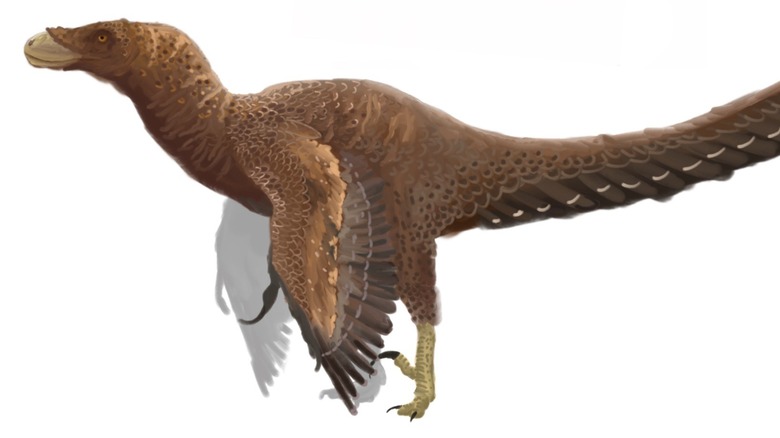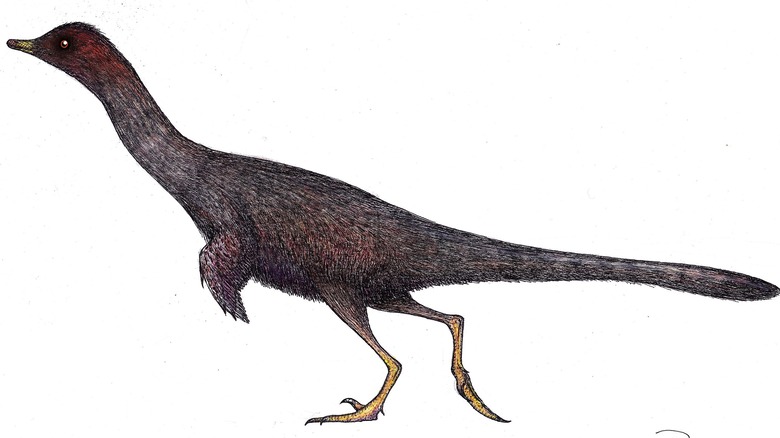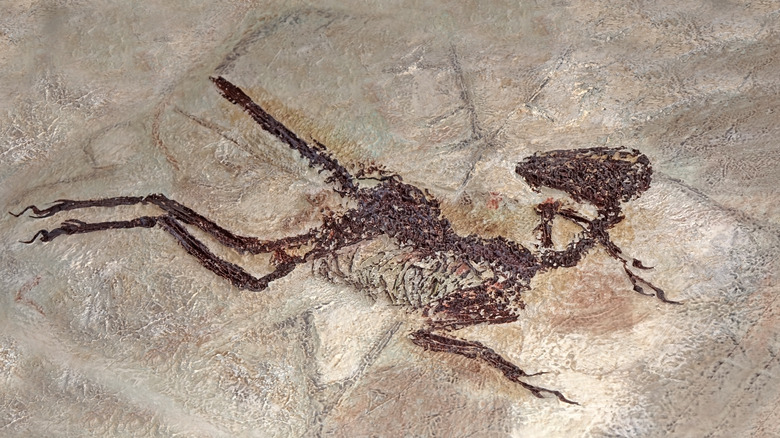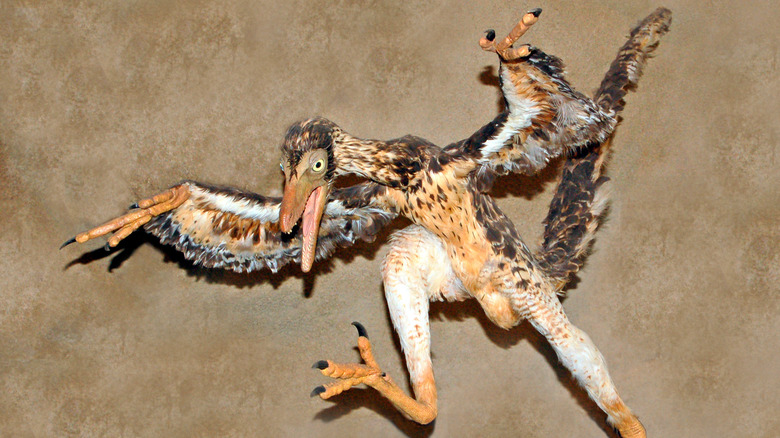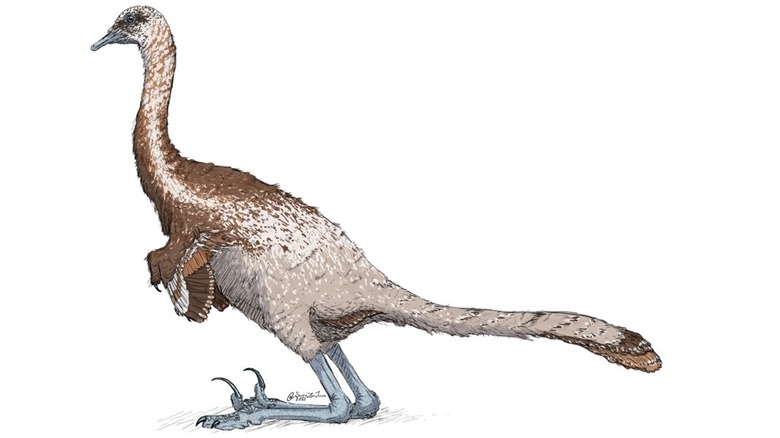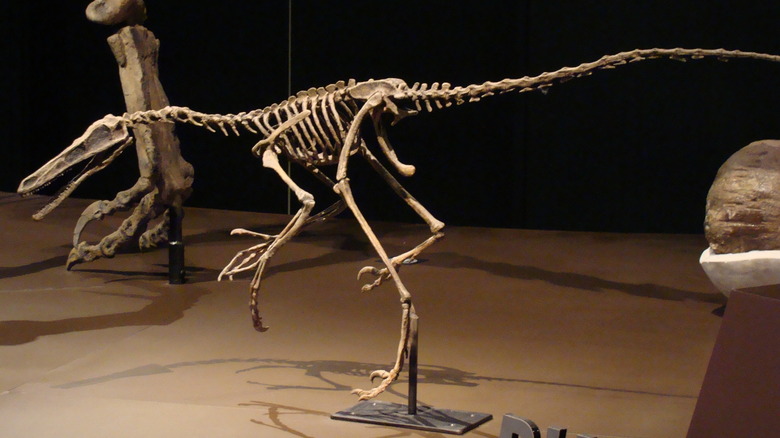14 Types Of Raptor Dinosaurs Explained
What is the scariest dinosaur in "Jurassic Park?" Many would vote for the monstrous Tyrannosaurus rex. Others may nominate the poisonous Dilophosaurus. Yet an argument can be made, such as by Screen Rant, that the scariest dinosaur of the franchise is the much smaller, stealthier, and intelligent Velociraptor. The terror of the Velociraptors may be because of their human size: They seem to become serial killers in a personal way that T-rex cannot.
Velociraptors are but one representative of a highly successful family of dinosaurs called Dromaeosauridae or the dromaeosaurs. In popular terms, these are usually dubbed raptors. According to Britannica, dromaeosaurs had shared traits as a group. They were relatively intelligent dinosaurs from the Cretaceous Period between 145.5 to 65.5 million years ago. They were distinctive by being agile, fast, and possessing long arms which could grasp prey. Many, if not all, species were feathered and were closely related to birds.
Most distinctive of raptors was the oversized middle claw of the foot, which was held up from the ground. Traditionally, it was believed to be used as a slashing weapon. However, as research published in PubMed shows, it has been argued that it may have been used for digging, hooking, or just subduing prey. This last use seems the most likely while teeth and claws dispatched the victim. No matter the case, you would not have wanted to be on the wrong side of a raptor claw. Let's take a look at some of these nimble Cretaceous killers.
Velociraptor
Velociraptor is probably the most famous — and misunderstood — of the dromaeosaurs. In "Jurassic Park," these beasts were depicted as intelligent human-sized, scaly killers that hunted in packs, as CNET describes. The truth is, as National Geographic points out, the Velociraptor of modern fiction is not the one that would have roamed central and eastern Asia during the Cretaceous.
First described in 1924 by the famous paleontologist Henry Fairfield Osborn (per the UK's Natural History Museum), Velociraptors were small, weighing up to about 100 pounds. They were also feathered and likely hunted alone, pinning their prey onto the ground with their large claw, much the way birds of prey do today. Velociraptors also had an excellent sense of smell and sight, likely being nocturnal. They were decently fast, being able to run at up to 24 miles per hour (hence the meaning of their name "Fast Thief," per Live Science), but nowhere near the speed shown in the movies.
If you were to go back in a time machine to the Cretaceous, you probably wouldn't have to fear Velociraptor predation. It is likely they subsisted on reptiles and small mammals. Still, there is one intriguing fossil of a larger Protoceratops seemingly locked in combat with a Velociraptor.
Deinonychus
By size, at least, the real raptor of "Jurassic Park" should have been Deinonychus. This North American dromaeosaurid was a bigger version of Velociraptor, being about double the size (per Smithsonian). Like others in the raptor family, it also sported a long, stiff tail which, as Britannica explains, made an excellent counterbalance to the forward-leaning body while pursuing prey.
Deinonychus was discovered in the 1960s by the paleontologist John Ostrom who also gave it its name, which means "terrible claw." According to "Discovering Dinosaurs," analysis of the bone structure started to link this raptor with the birds. Moreover, Berkeley University explains how Ostrom was taken by just how athletic and agile Deinonychus appeared to be, which was at the time at odds with the prevailing image of dinosaurs being sluggish.
This gave way to speculation that Deinonychus was a pack hunter based on loose fossil evidence. This hypothesis is still hotly debated. As "Dinosaur Paleobiology" points out, the evidence of such behavior is limited, and the closest living relatives of Dromaeosauridae — birds and crocodiles — typically do not hunt in packs.
Microraptor
Microraptor, as the name suggests, is a very small genus of raptor. The UK's Natural History Museum pegs its weight at a little over two pounds with a 2.6-foot-long body. This made Microraptor perhaps a touch bigger than a raven.
The dinosaur also had ravenesque characteristics. Not only did it have feathers, but the American Museum of Natural History explains that it sported a set of flight feathers on both the front and rear legs. This indicated that Microraptor engaged in possibly powered flight, or at least glided among the forest treetops in today's China, which it called home. Microraptor may have also used its back wings as sort of an airfoil, much like a biplane, which scientists tested using models and a wind tunnel.
National Geographic tells us that this little raptor regularly ate early birds. Fossil evidence shows that the dinosaur swallowed its prey head first, like many modern birds. And Microraptor would have looked very similar to a modern crow, since research reported by the Smithsonian tells us that Microraptor is one of the few dinosaurs we are fairly certain to know the color of: It was an iridescent black.
Utahraptor
The largest and probably scariest of the raptors hails from Utah — hence the name Utahraptor. Discovered in 1991 by Utah state paleontologist Jim Kirkland, Smithsonian describes this dinosaur as mainly like Velociraptor or Deinonychus — except bigger. How big? Utahraptor weighed up to 600 pounds with a length of 23 feet and wielded a large switchblade claw that was nothing to be trifled with. Utahraptor was also one of if not the earliest dromaeosaur. Eastern Utah State's Prehistoric Museum dates Utahraptor to the early Cretaceous, 125 million years ago.
In 2001, a trove of Utahraptor fossils was found in the Moab. These specimens, likely the victims of quicksand, have given us greater insight into this prehistoric predator. Utahraptors were generally bulkier than other raptors, meaning that they may have relied more on brute strength than agility. Also, based on groups of fossils together and studies of trackways, it is possible, but uncertain, that it lived in groups.
Utahraptor is so awe-inspiring that it was nominated to become Utah's official state dinosaur. However, the Jurassic Era Allosaurus already had the honor based on the number of specimens found in the state. A compromise was finally reached, with Utahraptor becoming the state dinosaur while Allosaurus found new prestige as the official state fossil.
Dromaeosaurus
Dromaeosaurus has given its name to the entire family of dromaeosaurids. The species was first discovered in 1914 by the famed fossil hunter Barnum Brown, who collected for the American Museum of Natural History. Brown is better known for discovering Tyrannosaurus rex, but he also collected troves of other fossils. Among these were the first raptors, which, according to "The Story of the Dinosaurs in 25 Discoveries," he discovered near the Red Deer River in Alberta.
McGill's Redpath Museum tells us that Dromaeosaurus was about six feet long and weighed about 55 pounds. Practically speaking, it would come up to about an adult person's chest, like a wolf. It immediately impressed those scientists who studied it since, even then, it was evident that the creature was built for speed. Hence, per "Dinosaurs by the Decade," the name Dromaeosaurus literally means "fast-running lizard." Unfortunately, little is known about this species since fossil findings of Dromaeosaurus are very rare.
Austroraptor
The vast majority of raptors have been found in the Northern Hemisphere, particularly in North America and Asia. However, raptors also made their way to the Southern Hemisphere. There is perhaps no grander example of this than Austroraptor, which literally means, according to "A Field Guide to Mesozoic Birds and Other Winged Dinosaurs," "Southern Thief."
Discovered in Argentina, Austroraptors were one of the larger dromaeosaurs. Smithsonian tells us that these carnivores grew up to 21 feet long. Other differences included shorter arms (its wings were probably not visible among its feathered plumage) as well as a longer snout. Interestingly, the arms are demonstrative of an evolutionary trend among large predatory dinosaurs. As predators grew in size, the arms grew proportionately smaller. For example, think of Tyrannosaurus rex's relatively puny arms.
"A Field Guide to Mesozoic Birds and Other Winged Dinosaurs" supposes that Austroraptor's longer snout, coupled with its fluted teeth, made this dinosaur an ideal fish hunter. This beast may have stalked Cretaceous rivers, snatching prey like a heron — except much larger and with teeth.
Dakotaraptor
Possibly the most famous dinosaur fossil dig site is the Hell Creek formation of the American West, which has yielded several famous Cretaceous fossil finds. Britannica lists Tyrannosaurus and Triceratops among the fossils found there, which have greatly enriched our knowledge and imagination of the dinosaurs and their world. In 2015, Hell Creek yielded its first dromaeosaurid, Dakotaraptor.
According to Smithsonian, Dakotaraptor was large in size (about 17 feet long) but had the athleticism of the smaller raptors, such as Velociraptor and Deinonychus. It is speculated that the beast may have used its wings not for flight but to help pin and trap prey. It would have filled an ecological niche at the time, being a medium-sized predator between the smaller carnivorous dinosaurs and the immense Tyrannosaurus rex.
Paleontological Contributions, which published the original description of Dakotaraptor, asserts that it probably did not compete for the same prey as a full-grown Tyrannosaurus, since they wouldn't have gone for the huge herbivores. However, it is conceivable that they may have come into conflict with younger Tyrannosaurids.
Rahonavis
Rahonavis is considered to be one of the earliest forerunners of birds. "The Bird: A Natural History of Who Birds Are, Where They Came From and How They Live" tells us that this small dromaeosaur, which lived in Madagascar, was likely about the size of a crow and could probably fly. According to "Flying Dinosaurs," its name comes from Malagasy, the language of Madagascar, and literally means "menacing cloud bird."
Rahonavis has been compared to the most famous early ancestor of birds, Archaeopteryx. Like Archaeopteryx, Rahonavis had a lizard-like tail and sickle claw. However, Rahonavis had fewer vertebrae, and the spaces therein seemed to allow for greater airflow than Archaeopteryx.
Rahonavis does have some controversy attached to it. "Living Dinosaurs" explains that scientists have been debating whether or not it should be considered a bird or a dromaeosaurid. Some would just as soon toss the species entirely into the bird category, but in truth, it seems to be both. Rahonavis appears to be a transitory species between more advanced types of birds and the earliest Archaeopteryx. While it may have been a more advanced flier than Archaeopteryx, it is assumed that it was still a primitive form of birdhood that required a good running start to get airborne.
Bambiraptor
One raptor was discovered by a teenager and subsequently named after a Disney icon. According to "Dinosaurs: A Visual Encyclopedia," in 1995, Wes Linster was fossil hunting in Montana's Glacier National Park — as 14-year-olds do — when he came across a tiny skeleton.
Analysis by paleontologists found that it was an exciting new species of raptor. "Feathered Dinosaurs" tells us that the scientists who described the fossil named it Bambiraptor. Yes, this dinosaur is named after Bambi from the Disney movie. However, this was not due to its disposition but rather its small size (Bambiraptor weighed about 4.4 pounds and was a little over two feet long. The American Museum of Natural History describes it as a "fierce hunter" of small mammals and reptiles.
Interestingly, Bambiraptor was the Albert Einstein of dinosaurs, having the highest relative ratio of brain to body size (known as the encephalization quotient). It was thought that it may have been as smart as a small bird of today. So Bambiraptor was, indeed, bird-brained.
Halszkaraptor
Cretaceous Mongolia was home to one of the most curious of raptors, Halskaraptor. This dromaeosaur was different from others in that it had long legs and a long, swan-like neck. More intriguing still is that, according to Science, this raptor was more upright than other dromaeosaurs. It also possessed tiny bones at the tip of its snout that seemed to be connected to blood vessels and nerves.
It had a duck-like appearance, or at least its face did, though it did have a considerable number of tiny sharp teeth. "Investigating Fossils" explains how when it was first exhibited in Munich in 2011, some thought it was a hoax fossil since the sum of its parts did not make sense.
However, X-ray scans have since shown that Halszkaraptor was indeed genuine. This has led researchers to conclude that Halskaraptor was a dromaeosaur that evolved into an aquatic or semi-aquatic lifestyle. Research published in the National Library of Medicine asserts that it had a sensitive type of bill used to find and hunt fish in the Cretaceous waterways.
Zhenyuanlong
In recent decades, fossil discoveries in China have revolutionized our understanding of dinosaurs. One example is the feathery raptor Zhenyuanlong from the early Cretaceous, a name which means "Zhenyuan's Sun Dragon" — after the man who discovered it.
National Geographic, in its profile of Zhenyuanlong, notes that although the creature was larger than other dromaeosaurs of the time and region, being about five feet long, it had well-developed feathers on the arms and tail, which were probably not used for flight. The arms were far too short, as were the multiple layers of feathers.
Many early raptors have been found to have protofeathers, a fuzz that probably developed to help insulate them. These protofeathers have supported arguments that these creatures were endothermic, since they helped to maintain a steady body temperature. But having complex feathers on such an animal is more difficult to explain. This has given rise to some theories that they may have improved grip, or were used to entrap prey. In any case, Zhenyuanlong is still being figured out, but it does have one of the coolest descriptions given to it by paleontologist Steve Brusatte per "Weird Dinosaurs": a "fluffy, feathered poodle from hell."
Sinornithosaurus
Another raptor discovered in China is Sinornithosaurus, which literally means "Chinese bird lizard." This dromaeosaurid grew to about 6.5 feet in length and, according to the Natural History Museum, roamed the early period of the Cretaceous.
Shortly after its discovery in the late 1990s, paleontologists puzzled over the nature of its teeth. National Geographic explains that scientists observed narrow grooves down the length of some of the teeth. This led some to speculate that these grooves were used to deliver poison. Speculation about poisonous dinosaurs is nothing new: "Jurassic Park" featured one Dilophosaurus which spat poison at its victims.
If true, this may make Sinornithosaurus a contender for the title of coolest dinosaur. However, further detailed research of the skull showed no supporting evidence that this raptor had a deadly bite. In fact, there is no evidence that any dinosaur was poisonous. Nonetheless, this was a small, active predator, which, according to "Dinosaurs: A Visual Encyclopedia," lived a busy lifestyle on the ground hunting small prey.
Mahakala
Mahakala was one of the smallest dinosaurs. However, its small size belies its importance to our understanding of how dinosaurs are related to birds. Mahakala hailed from Mongolia and, according to National Geographic, weighed less than two pounds but scored highly in pure cuteness.
Mahakala seems to have lived a ground-based foraging lifestyle similar to today's small, flightless birds. "A Field Guide to Mesozoic Birds and Other Winged Dinosaurs" points out that its wings were far too small for flight: While it had feathers, the plumage was likely more threadlike, such as a modern kiwi.
Mahakala demonstrates how miniaturization in evolution worked. "Flying Dinosaurs" states that although Mahakala existed after birds had evolved, it is believed to have a common ancestor with them deep in the Mesozoic period. "Birds of Stone" supports this link, asserting that Mahakala's growth rate shows that it developed at the same rate as birds. Because Mahakala was so small, it is seen as evidence supporting how as dinosaurs became increasingly bird-like, they became smaller — following the logic that in order to fly, you need to be lighter and smaller.
Buitreraptor
The oldest known raptor species from South America is the Buitreraptor. "Feathered Dinosaurs" tells us that this small dromaeosaurid inhabited western Argentina during the Middle Cretaceous. This was in the same region where such gigantic predators as the almost 9-ton Giganotosaurus roamed.
Discovered by two brothers, Jorges and Fabian Gonzalez, Buitreraptor stands out from other raptors because of its elongated snout and spaced teeth. These teeth, unlike other raptors, were not serrated and its arms and legs were longer compared to other dromaeosaurids. They were designed more for catching than for cutting. While this raptor was turkey-sized, their lifestyle was not very turkey-like.
What Buitreraptor's body plan implies is a quick snatching and seizing speed. It is supposed that this animal made its living by fishing and catching small prey, in the semiarid floodplains and forests of its home in western Argentina (per "The Princeton Field Guide to Dinosaurs"). To visualize how this might look, it has been compared to the nimble movements of a secretary bird.
